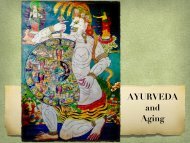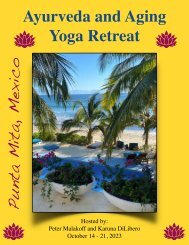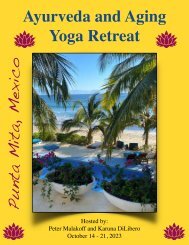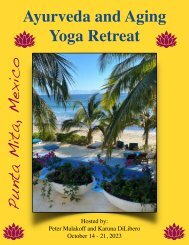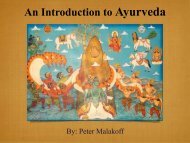How Thoreau's Walden Pond Mixed with the Ganges and Yoga Came to America with Swami Vivekananda
One early morning in 1846, during the coldest days of a New England winter, Henry David Thoreau looked out the window of his small cabin on Walden Pond and saw men cutting its ice into blocks. That ice was hauled by horse to a railroad that ran across the western edge of Walden Pond, packed into a boxcar, taken to Boston and loaded onto a clipper ship that sailed to Calcutta, India, arriving about four months later. Once there, that ice was purchased by grateful members of the East India Company. Thoreau had witnessed a small part of the global ice trade between New England and India that took place during the latter part of the nineteenth century. When Thoreau considered the ice trade, his vision sailed on metaphors far beyond the scope of business. The waters he imagined flowed both east and west and carried not just natural elements, but culture, religion and philosophy as well. He envisioned that after arriving in Calcutta, the New England ice of Walden Pond would eventually melt and run downhill where it would join with the sacred water of the Ganges. He wrote in Walden: "It appears that the sweltering inhabitants of Charleston and New Orleans, of Madras and Bombay and , drink at my well. In the morning I bathe my intellect in the stupendous and cosmogonal philosophy of the , since whose composition years of the gods have elapsed, and in comparison with which our modern world and its literature seem puny and trivial; and I doubt if that philosophy is not to be referred to a previous state of existence, so remote is its sublimity from our conceptions. I lay down the book [Bhagavad-Gita] and go to my well for water, and lo! there I meet the servant of the Bramin, priest of and and who still sits in his temple on the Ganges reading the , or dwells at the root of a tree with his crust and water jug. I meet his servant come to draw water for his master, and our buckets as it were grate together in the same well. The pure Walden water is mingled with the sacred water of the Ganges." This book tells the story of these waters . . .
One early morning in 1846, during the coldest days of a New England winter, Henry David Thoreau looked out the window of his small cabin on Walden Pond and saw men cutting its ice into blocks. That ice was hauled by horse to a railroad that ran across the western edge of Walden Pond, packed into a boxcar, taken to Boston and loaded onto a clipper ship that sailed to Calcutta, India, arriving about four months later. Once there, that ice was purchased by grateful members of the East India Company. Thoreau had witnessed a small part of the global ice trade between New England and India that took place during the latter part of the nineteenth century.
When Thoreau considered the ice trade, his vision sailed on metaphors far beyond the scope of business. The waters he imagined flowed both east and west and carried not just natural elements, but culture, religion and philosophy as well. He envisioned that after arriving in Calcutta, the New England ice of Walden Pond would eventually melt and run downhill where it would join with the sacred water of the Ganges. He wrote in Walden: "It appears that the sweltering inhabitants of Charleston and New Orleans, of Madras and Bombay and , drink at my well. In the morning I bathe my intellect in the stupendous and cosmogonal philosophy of the , since whose composition years of the gods have elapsed, and in comparison with which our modern world and its literature seem puny and trivial; and I doubt if that philosophy is not to be referred to a previous state of existence, so remote is its sublimity from our conceptions.
I lay down the book [Bhagavad-Gita] and go to my well for water, and lo! there I meet the servant of the Bramin, priest of and and who still sits in his temple on the Ganges reading the , or dwells at the root of a tree with his crust and water jug. I meet his servant come to draw water for his master, and our buckets as it were grate together in the same well. The pure Walden water is mingled with the sacred water of the Ganges."
This book tells the story of these waters . . .
Create successful ePaper yourself
Turn your PDF publications into a flip-book with our unique Google optimized e-Paper software.
Hatha <strong>Yoga</strong><br />
“Traditional hatha yoga is a holistic yogic<br />
path, including disciplines, postures (asana),<br />
purification procedures (shatkriya), gestures<br />
(mudra), breathing (pranayama), <strong>and</strong> meditation.<br />
The hatha yoga predominantly practiced<br />
in <strong>the</strong> West consists of mostly asanas unders<strong>to</strong>od<br />
as physical exercises.”<br />
– Wikipedia, The Free Encyclopedia<br />
(Above) B.K.S Iyengar - One of <strong>the</strong> best known teachers of Hatha <strong>Yoga</strong> in<br />
<strong>the</strong> twentieth century<br />
The classic text of Hatha <strong>Yoga</strong> is <strong>the</strong> Hatha <strong>Yoga</strong> Pradeepika:<br />
“The Haṭha <strong>Yoga</strong> Pradīpikā (Sanskrit: haṭhayōgapradīpikā, is a classic Sanskrit<br />
manual on hatha yoga, written by Svāmi Svātmārāma, a disciple of <strong>Swami</strong><br />
Gorakhnath. Said <strong>to</strong> be <strong>the</strong> oldest surviving text on <strong>the</strong> hatha yoga, it is one of<br />
<strong>the</strong> three classic texts of hatha yoga, <strong>the</strong> o<strong>the</strong>r two being <strong>the</strong> Gher<strong>and</strong>a Samhita<br />
<strong>and</strong> <strong>the</strong> Shiva Samhita. A fourth major text, written at a later date by Srinivasabhatta<br />
Mahayogaindra, is <strong>the</strong> Hatharatnavali.<br />
The text was written in 15th century CE. The work is derived from older Sanskrit<br />
texts <strong>and</strong> <strong>Swami</strong> Svatmarama's own yogic experiences. Many modern English<br />
translations of <strong>the</strong> text are available.<br />
The book consists four Upadeśas (chapters) which include information about<br />
asanas, pranayama, chakras, kundalini, b<strong>and</strong>has, kriyas, shakti, nadis <strong>and</strong> mudras<br />
among o<strong>the</strong>r <strong>to</strong>pics. It runs in <strong>the</strong> line of Hindu yoga (<strong>to</strong> distinguish from<br />
Buddhist <strong>and</strong> Jain yoga) <strong>and</strong> is dedicated <strong>to</strong> Śrī (Lord) ādi nāthā (Adinatha), a<br />
name for Lord Shiva (<strong>the</strong> Hindu god of destruction <strong>and</strong> renewal), who is believed<br />
<strong>to</strong> have imparted <strong>the</strong> secret of hatha yoga <strong>to</strong> his divine consort Parvati.”<br />
– Wikipedia, The Free Encyclopedia<br />
Ramakrishna <strong>and</strong> his disciples always considered Hatha <strong>Yoga</strong> in terms of<br />
God-Realization. It is not that <strong>the</strong>y thought is bad for a person. Only that it had<br />
very little or nothing <strong>to</strong> do <strong>with</strong> what <strong>the</strong>y held <strong>to</strong> be <strong>the</strong> supreme goal of life –<br />
God Realization.<br />
“Have you dived deep in<strong>to</strong> Shivan<strong>and</strong>a’s pamphlet on Hatha <strong>Yoga</strong>? You must<br />
not be deluded by what Hatha <strong>Yoga</strong> teachers say. For Shivan<strong>and</strong>a (<strong>Swami</strong> Shivan<strong>and</strong>a,<br />
an intimate devotee of Sri Ramakrishna) is right. If you learn <strong>to</strong> control<br />
your breath, if you increase your powers of concentration, all those things<br />
tend <strong>to</strong> make you strong. Even physical health is affected by <strong>the</strong>m. Na tasya roga<br />
na jara na mrtyu praptasyayogagnimayam shariram – he has no age, disease, nor decay,<br />
who has put on <strong>the</strong> flame garb of <strong>Yoga</strong> [Hatha <strong>Yoga</strong>].<br />
That is true, but perpetual youth is no good <strong>to</strong> you if you cannot find Him, <strong>the</strong><br />
ageless, who does not have <strong>to</strong> be even young . . . There is no doubt that while<br />
concentrating on <strong>the</strong> Divine, <strong>the</strong> Rishis, sages, sages of ancient India, stumbled<br />
upon <strong>the</strong> science of <strong>Yoga</strong> [Hatha <strong>Yoga</strong>]. It was just an incident of <strong>the</strong>ir spiritual<br />
life. Alas, unfortunately, later came a race of bastard holy men who did not care<br />
much for God. They wanted fireworks, so <strong>the</strong>y prostituted <strong>Yoga</strong> in<strong>to</strong> a science<br />
for acquiring occult power. “<br />
A discussion between <strong>Swami</strong> Nikhilan<strong>and</strong>a <strong>and</strong> ano<strong>the</strong>r <strong>Swami</strong>.<br />
Taken from: Gospel of Sri Ramakrishna, Nikhilan<strong>and</strong>a







